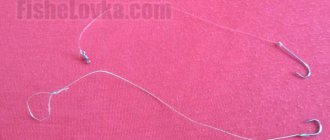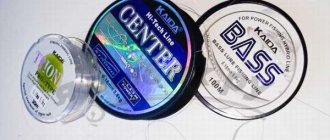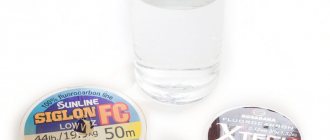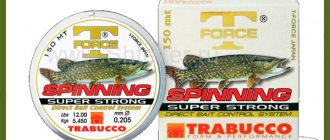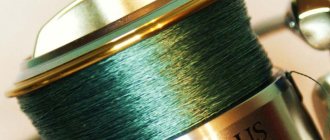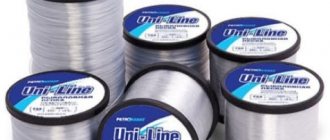Fishermen do not always use the terminology accepted among professionals. It happens that someone has been fishing all their life and did not know that this type of fishing has its own special name. This applies to match fishing - fishing with a light plug rod with a reel over long distances, which is also designed for catching large fish.
An important component of the match equipment is the match line, which must be sinking. Such a fishing line appeared recently about 20 years ago. Well, now it is used with might and main for match fishing and feeder fishing.
According to my observations, many fishermen use universal gear, which can be used to fish near the shore and make “long casts.” In this case, they use any fishing line, without really thinking about any special equipment. After all, in practice, you can drown any fishing line.
For real match fishing, everything must correspond to just such fishing, including the fishing line, which is described in this article. I mean that whoever reads this article understands all the nuances of match fishing.
At first glance, it may seem that such rough tackle will not bring results and will frighten the fish, but in practice this is not the case. The fish is especially shy near the coastline; at depth it feels much freer and pays less attention to gear.
Many manufacturers have a line for match fishing. The line spool is labeled Match or Sinking. But there are quite a lot of requirements for such a fishing line, so not all companies produce it.
Peculiarities
Since fishing with a match rod takes place in still water or in the presence of a very weak current, the line will be submerged in the water. This is a feature of this kind of fishing.
The second difference between this type of fishing is the distance; casting can occur at a distance of 70-100 meters, which is quite far.
Since the line is in calm water, it does not sail or move under the influence of the current.
Browning Cenex Sinking Match Lin
Features and classes of match rods
Let us note right away that match and Bolognese fishing rods are not the same thing. Match rods are more powerful. As a rule, they consist of 2 - 3 sections connected via plug units, while bologneses have a telescopic design. True, telescope matches are also not uncommon. But they are distinguished by a more reliable reel seat, rings on high supports and a comfortable cork or Duplon handle.
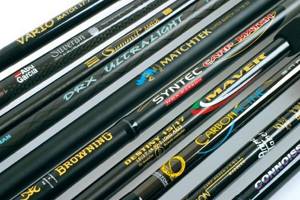
The basis of a match rod is a delicate blank with a length of 3.6 to 4.8 m. Modern matches are made of high-modulus carbon, so they are both light and durable. A large number of guide rings in lightweight frames most efficiently distribute the load throughout the blank and ensure unhindered slipping of thin fishing line when casting. The task of a match rod is to ensure the longest cast of light float rigs and comfortable, confident landing of large fish. However, depending on their purpose, match rods are divided into several classes:
- classic for light rigs and fishing in currents and calm waters;
- carp for catching carp, carp and other large fish;
- “long-distance” for fishing at long and ultra-long distances.
Not only its length and power, but also its action and test directly depend on the class of the rod. Therefore, when starting to choose a match fishing rod, you must first decide where, in what conditions and what kind of fish you will catch. Otherwise, there is a risk of ending your fishing just as you started it.
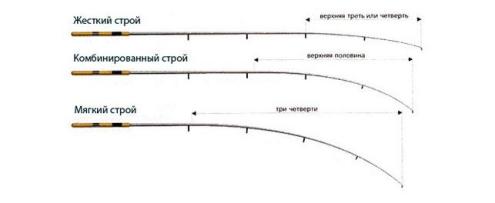
If you are going to catch crucian carp, roach, bream, tench and other fish up to 3 kg from a distance of up to 30 meters, you will need float equipment weighing up to 20 g. It is best handled by classic match rods, the length of which is from 3.9 to 4 .2 m. As a rule, such fishing rods have a medium-soft or soft action, which makes casting comfortable and effectively dampens jerks of fish during fishing. Match rods for carp fishing are more powerful and heavier than classic ones. This is because they must withstand the resistance of large fish and at the same time have every opportunity to cast light rigs as far as possible. Therefore, the structure of carp matches is usually medium or soft. When choosing the most versatile option, you may be tempted to buy a match rod for carp fishing, because it provides a good margin of safety for classic fishing. However, we must not forget that ordinary match fishing involves frequent recasts due to the drift of the float by the current and idle bites. Whether it will be comfortable to catch “palm-shaped” roach with a heavy fishing rod is up to you to decide.
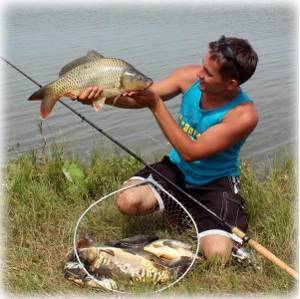
Finally, the third class of match fishing rods is “long-range”. Their main task is to deliver the float as far as possible - to a distance of up to 70 m. This cannot be done with light equipment and short rods. Therefore, “long-range fish” are characterized by a length of 4.2 meters and a bait test of 20 to 40 and even 60 g. Hence the increased power and weight in comparison even with carp fish. The structure of match rods for long casts is either medium-hard or hard. The increased rigidity should compensate for the stretchability of the line when hooking. After all, from a distance of 40 - 60 meters it is rarely possible to hook a fish with a soft-action rod.
Primary requirements
The fishing line for match fishing must meet certain requirements:
The line should sink easily
Regular monofilament lies on the water after casting and does not sink. The packaging of match fishing line should have the designation “sinking line”, which means sinking. In order to increase the sinkability, manufacturers cover monofilament with special coatings in two or three layers. Thus, its specific gravity relative to water increases.
But the fishing line shouldn’t be very heavy either. Otherwise, it will sink to the bottom and hooking will become more difficult. And when casting long distances, a sharp hook is very important.
How to make a fishing line sink
You can make the fishing line sink yourself. To do this, wipe it with liquid soap or “Fary”. It is necessary to completely degrease the fishing line. Fatty deposits help keep it floating on the water. Instead of liquid soap, use a special match spray. The effectiveness of the spray is much higher than that of household products.
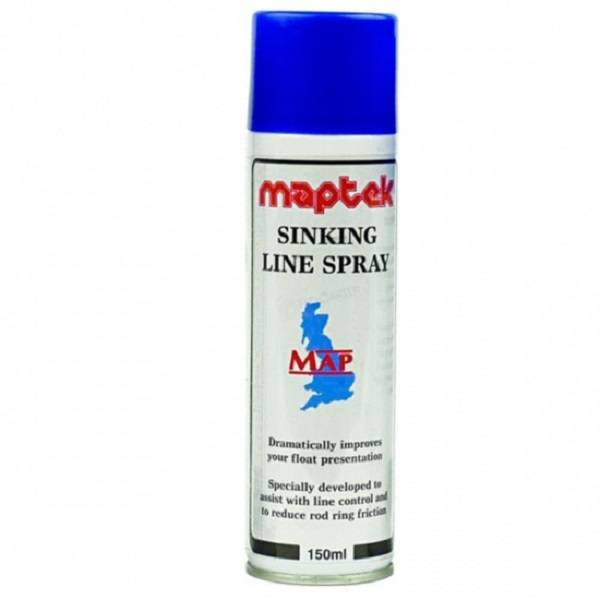
Degreasing spray
Softness and elasticity
This allows for a freer release of the spool and also allows for better winding onto the reel.
Abrasion resistance
The match fishing technique consists of numerous casts. Consequently, the fishing line will constantly experience friction against the reel and guide rings. Therefore, it is very important that the fishing line does not wear out or fray.
Low extensibility
Low stretch will ensure a tight hook.
Lack of "memory"
It should not only be unconscious, but also straighten out in a straight line after casting. Do not curl into rings, but lie flat on the water. If it was twisted, straighten it out. For the same purpose, manufacturers have come up with a special parallel winding on the bobbin, which prevents twisting.
Many people ask the question: how to straighten the fishing line? It turns out that this can be done at home. For example, hang a weight and heat the line with a hairdryer, the rings will go away. Another way to straighten a fishing line is to run it across the hot surface of an iron, kettle or pan. In any case, the heating process promotes straightening.
Dark color
The line should be dark.
Firstly, so that you can mark on it with a marker the distance to which the cast was made. Usually black, dark blue or dark brown. The use of markers is a prerequisite for match fishing. The price of the marker is not important, they are all about the same. Both expensive and cheap markers draw well.
Secondly, the dark color is similar to the color of the bottom, which means the fishing line is hardly noticeable.
Equipping a match fishing rod
If you take a closer look at the finished match rod, it is worth noting some similarities with a spinning rod or feeder. This is confirmed by the plug-in three-piece design with a cork handle and reel seat, as well as miniature match rings in large quantities. Astrakhan fishermen most often prefer a stick with a length of 3.6-4.2 m, however, this parameter is determined by the fishing conditions.
A high-speed rear-friction spinning reel with a gear ratio of 5.5:1 is the most common option in match rods. To mark such reels, the letter “M” is indicated - short for “Match” with a hint of belonging to a specific equipment.
- Attention! When selecting a float, we take into account that it is radically different from the standard shape in its increased length and spindle-shaped structure.
When choosing a float, it is worth noting its increased weight in order to perform long-distance and accurate casting at a distance of at least 30 m. Its own load - removable washers, is located in the lower part of such a float. They are ideal for organizing sensitive adjustment of the sensitivity of the entire gear as a whole. The average weight of long-range floats is 25-30 g. To reload it and obtain a working position, pellets are used as a full-fledged feed. The large weight and impressive dimensions make this accessory quite interesting; it exhibits excellent sensitivity and transmits the slightest touch of the fish when biting - it can be easily recessed or raised.
The match fishing rod has a fairly simple design of a sliding float. The main line is equipped with a silicone stopper to limit the travel of the float. A float is attached to a special match bead with a clasp. After threading the lower silicone stopper to the main line, the classic equipment is mounted. We tie a swivel to the end of the working line and mount a leash with hooks to it.
- Advice! In accordance with the fishing conditions or lighting conditions, the float attached to the bead with a clasp changes quite quickly.
How to drown
In order for the fishing line to sink, it must be submerged. Sink the line with jerking movements. First you need to lower the tip of the rod into the water, take up the slack and lift it sharply. Those fishing lines that sink worse are sunk in two approaches.
Not all lines sink the same way. They are divided into two subgroups:
- Sinking quickly.
- Conditionally drowning.
Of course, it is preferable to purchase fishing lines that sink quickly and are labeled Full Sinking Line, but their price is higher.
The best manufacturers
The leaders in the production of such fishing lines are Japanese and German companies. Using their raw materials, Italians and Poles produce good fishing lines.
Match fishing line from Trabucco has proven itself well. The earlier one is the Trabucco Diamond Sinking Line, the new generation product is the Trabucco T Force XPS Match Sinking line.
Trabucco fishing line was designed specifically for fishing with a match rod, as well as for feeder fishing. Black color. The Trabucco T-Force line has a high weight, which helps it sink in a short period of time. Trabucco T-Force has ceramic added to its structure, which adds strength to the monofilament. Trabucco line is parallel wound.
Trabucco T Force XPS Match Sinking
Maver Smart Dual Band is a Japanese fishing line that is made of two threads using the squeezing method. Quite soft, blue-gray color. Maver Smart Dual Band is used for match fishing, as well as for feeder fishing, float fishing rods and spinning rods. Treated with resins that protect it from abrasion. Since the fishing line is made of two monofilaments of different colors, its diameter is not round, which worries those who buy it for the first time. But it's not fake. Works very well when fishing for carp. Not suitable for small fish - it drags.
Maver Smart Dual Band Line is easier to break than Trabucco Line
Another fishing line from Maver is Smart SLR, the reviews are very positive. The Maver SLR is called a legend. Smart SLR is used not only for match fishing, but also for winter fishing. Maver SLR - soft and elastic with almost no memory, the diameter corresponds to the declared one. A significant disadvantage of the Maver SLR is the price. But Maver SLR is often counterfeited. Of course, a fake will not have the characteristics of the original.
The German company Browning produces excellent match fishing lines:
- Browning Cenex Sinking Match Line – sinks quickly and has low memory.
- Browning Cenex Sinking Line NEW – transparent, very easy to melt.
Colmic Arwen Inglese Super Competition Sinking Line - replaced the popular RACE Sinking Line. RACE Sinking is currently out of production. Colmic Arwen is marsh-colored, has low extensibility and poor memory. Arwen Sinking has the following diameter: 0.148 mm; 0.168 mm; 0.185 mm; 0.205 mm; 0.230 mm. User reviews say that the diameter is slightly lower than it actually is.
Folk sign: As soon as the bite begins, you should under no circumstances look back or look around, the bite will stop immediately!
Source: KakUlov.ru
What fishing line is required for match fishing?
Currently, purchasing such a forest is not difficult. Your choice should be made from a well-known manufacturer, which will allow you to be confident in its reliability. You can recognize the forest by the “match” marking on the box. It is also necessary to find another o which indicates that the forest is submerged in water.
In most cases, it is monofilamentous wood, ranging from gray to black in color. It has a minimum of memory, that is, it does not curl up after winding on the spool and straightens out perfectly. By the way, in this regard, the reel has its own requirements, which we wrote about in the article “Differences between a reel for match fishing and a regular spinning reel.”
Even a sinking forest can lose its properties and remain on the surface of the water. To prevent this from happening, sometimes it needs to be degreased. Stores sell a special spray that treats the wood directly on the spool. The spray can be replaced with dishwashing liquid.
How to choose a fishing line section
Regarding the cross-section of the line, the opinions of fishermen may differ diametrically. At various competitions, anglers mainly use line with a diameter of 0.1-0.12 mm; it allows them to deliver bait over fairly decent distances. It is also possible to use a thicker line of 0.15 mm, which is knitted together with a shock leader. This prevents the waggler from being shot off, since the load in this case falls on the shock leader.
An ordinary fisherman, in order not to bother with all these incomprehensible words, can use a section of 0.16-0.2 mm for the central line. And there is no need to be afraid that its thickness will affect the casting distance. But such a line will quite easily allow you to fish for small fish - silver bream, rudd, and if a trophy carp bites, it will not let you down at the right time.
When a shock leader is needed
So what is a shock leader and what does it serve?
This is a piece of scaffolding with a cross section of 0.18-0.22 mm, which is tied to the central scaffolding. All equipment is located directly on it. Its length is equal to two distances of the fishing rod and a few turns on the reel. The central scaffold and the shock leader are connected together with a special knot, which is so small that it does not significantly affect the range when sliding through the guide rings. What makes a shock leader convenient is that you can prepare several rigs at home for different fishing conditions, and in the field quickly change them by simply cutting them in the area of the knot. This significantly reduces the time compared to complete re-equipment of the gear.
Fishing lines that sink
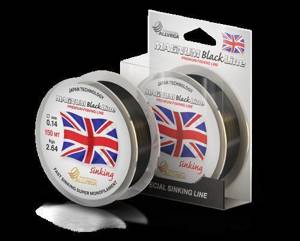
Sinking lines are special threads that sink in water. Typically, such threads are used for float fishing. Such threads should sink without delay and be invisible in the water. Sinking fishing line is mainly used in the middle of summer, because it is at this time that the fish go to the bottom and just such a fishing line is needed to catch them.
It has some unique properties compared to the usual one. Thanks to its composition, it is easy to control, and when it sinks, it is invisible to the fish, which makes it the best fishing line for deep fishing. To ensure that the thread is immersed in the water, you can lightly tug the thread with the rod. Despite the fact that a sinking thread looks common, not every fisherman can accurately tell about it, and seeing a fisherman with it is even more rare.
Conventionally, fishing lines can be divided into 2 types:
- Fast-sinking fishing lines (up to 0.15 mm in diameter and mostly made of monofilament).
- Ordinary fishing lines (sink worse than sinking ones with a diameter of 0.15 mm or more made from other materials).
Look carefully at the packaging of the fishing line; sinking fishing lines must have the inscription “sinking” on them!
Distinctive features of fishing lines
Each thread differs from other threads in its special properties. Marking helps fishermen, as well as manufacturers, with this, which will allow them to distinguish the threads from each other. Each thread has a designation. Marking is applied to the plastic reel, which indicates its main characteristics, such as diameter (usually measured in millimeters), package number, breaking load (usually measured in kg).
- Lines can also be designated in lb;
- European and Japanese lines usually measure breaking load in lb;
- in order to have an idea of how much this is in our kg, we give the proportion 2 lb = 1 kg. With its help, you can easily determine the breaking strength of the thread.
Remember that 2 lb = 1 kg in order to know the breaking load well!
A few points on the characteristics of the fishing line
When winding the line onto the spool, first think carefully about which one to give this or that preference. Remember that when fishing with matcha, the bait is scattered over a certain area of half a meter by half a meter. In this case, for the correct direction of casting, a landmark on the opposite bank is chosen, but the casting range cannot be determined by eye.
A permanent marker is intended for these purposes, which we wrote about in the article “Basic knowledge for which fishing with a match rod becomes successful.” The white mark is visible quite well on dark line, but if you use dark markers, then when looking from top to bottom, at the moment of reeling the tackle to the desired point, you can miss it, since it will merge with the ground.
Another factor. It’s not for nothing that at the beginning of the article we mentioned the softness of the line, because a hard line is like a spring, reducing the range and not allowing proper control of the tackle. It’s easy to determine the rigidity of the scaffold yourself:
- Cut a small piece of wood and fold it in half.
- Firmly squeeze the bend with your fingers.
- After the scaffold is released, it should straighten without any traces of breakage. In extreme cases, it should disappear if the line is slightly stretched at the ends.
There may be a concern that with a fairly soft line it will be difficult to instantly hook a fish at a remote distance. Practice shows that in the case of match fishing, doubts are groundless, since due to the large distance to the shore, the fish is not afraid of a catch. And the hooks in the match are not very large and do not require immediate hooking.
Match fishing line is quite easy to identify visually. Firstly, the line for match fishing in the sinking variants is somewhat heavier than the usual ones, so you can take a reel in both hands and feel the difference. Another factor is that the line is used for long-distance casting, so you need to read the footage on the package, which should be at least 150 m. By the way, most manufacturers produce line in uncut strips of 10 reels, and sellers cut the packaging for individual sales.
Source: www.udim.ru
What should be the match line | Tips for fishermen
Category: Match fishing2015-03-26Alex
Hello dear fishermen. In this article we will look at the features of choosing a fishing line for match fishing. Match fishing involves long casting, and you can’t do it without high-quality fishing line.
Of course, in any fishing tackle, the fishing line is the most important part, since it organizes some kind of connection between the angler and the fish. In match fishing, the fishing line needs to be given special attention, since the match tackle itself is something sophisticated and balanced.
Match fishing line, as a rule, is sinking. This parameter allows you to exclude external influences on the equipment, such as wind and current. When fishing with a match fishing rod, most often a certain point with a size of no more than 50 by 50 centimeters is fed. In this regard, when choosing a fishing line for match fishing, you should definitely take this parameter into account, since even a light breeze can take the bait away from the fishing spot to a considerable distance.
Also in the variety of fishing lines, there are also conditionally sinking fishing lines. They are cheaper than sinking lines, and are based on some kind of degreasing coating. As a rule, such fishing lines are no different from real match ones, but nevertheless, they are not as durable and are a little stiffer.
Features of choosing fishing line
When choosing a fishing line, you should pay special attention to its color. To determine the casting distance, you cannot use a clip, but rather use a special permanent marker. So, when using markers, it is better to give preference to white, and accordingly use dark shades of fishing line. Why this way and not otherwise? The fact is that we hold the rod at waist level, and other colors of the marker will simply blend into the ground. In the end, we came for fishing, and not for a competition: “find the mark on 150 meters of fishing line.”
It is also worth paying attention to the rigidity of the fishing line. As you know, rigid fishing line has the ability to turn into a spring, which reduces the casting distance and makes it impossible to control the equipment. I think it won’t be difficult for you to determine the rigidity of the fishing line, but just in case I’ll explain: Take a small piece and fold it in half, then squeeze the fishing line with your fingers at the bend. If, after compression, the line straightens out and there is no kink left, it is a good match line. In this case, the kink may remain, but if you pull the two ends of the fishing line, it will disappear.
Some anglers think that with a very soft line, it is not possible to hook fish at a long distance. This fear is quite justified for other methods of fishing, but not for match fishing. Firstly, fishing takes place at a considerable distance from the shore, and the bait does not arouse suspicion among the fish. Secondly, in match fishing, small hooks are used, fishing with which does not require a sharp hook.
How to determine if the fishing line is match
No matter how you make a mistake in a store, you should know a few rules. Firstly, match fishing lines are a little heavier than regular ones, and if you pick up a spool with regular fishing line and match fishing line, you can feel the difference in weight. Secondly, match fishing line is sold in reels with a reel length of 150 meters or more. This is due to the casting range of match gear, and the reserve for landing large fish.
In addition, most manufacturers produce match fishing line in packages of 10 reels, in which the fishing line is not cut, that is, you buy one and a half kilometers of fishing line. Some people won’t have the means to buy the packaging, but it’s still worth asking the seller if the fishing line came in that kind of packaging. Also, before going to the store, don’t be lazy, go online and read fishermen’s reviews about various manufacturers, this will help you navigate not only the issue of quality, but also choose a price category.
I look forward to your comments, dear readers. Subscribe to new articles via RSS.
fisherlive.ru

